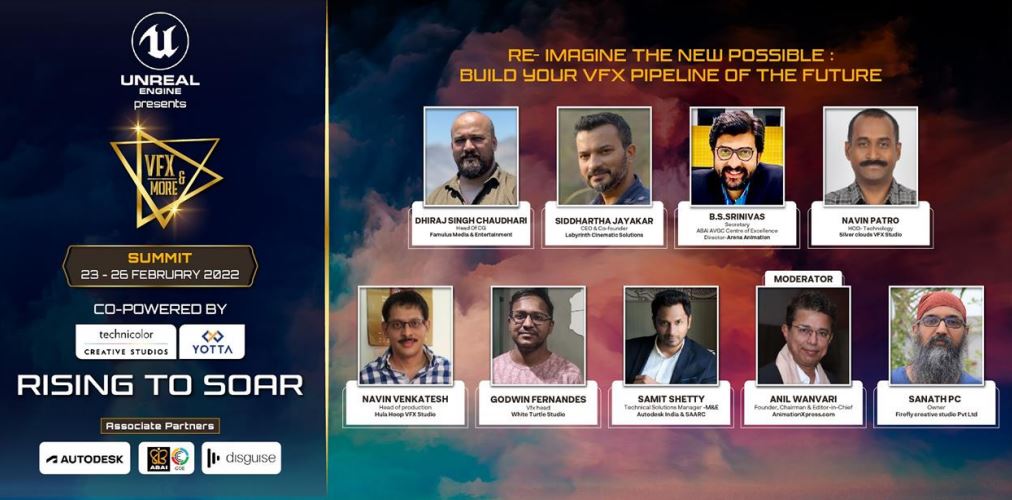
Day two of the VAM Summit included an engrossing panel discussion on the topic ‘Re-imagine the new possible for your VFX pipeline.’ The eminent speakers were: Famulus Media & Entertainment head of CG Dhiraj Singh Chaudhari, Labyrinth Cinematic Solutions CEO and co-founder Siddhartha Jayakar, ABAI AVGC Centre of Excellence secretary B.S. Srinivas, Hula Hoop VFX Studio head of production Navin Venkatesh, Silvercloud Studios HOD technology Navin Patro, White Turtle Studio VFX head Godwin Fernandes, Autodesk India & SAARC technical solutions manager – M&E Samit Shetty, and Firefly Creative Studio owner Sanath PC. The session was moderated by AnimationXpress.com founder, chairman and editor-in-chief Anil Wanvari.
Chaudhari kick-started the discussion with a presentation consisting of all the fabulous work like Mission Mangal, Special Ops, Occupation Rainfall, Famulus has done. Before presenting, he quickly briefed the audiences about his company’s work. He said, “Being a mid-sized studio, we have to deal with a lot of different format projects; hence our pipeline is very flexible, adaptable, and simple. Keeping the workflow simple helps us to automise with the help of tools and coding.”
While the pandemic changed the working methods of all the AVGC sectors, Samit added, “The most affected industry in the AVGC group would be VFX since the shoots were not happening. That’s why there was a need for creating a new pipeline to fulfil the trends and meet the virtual production needs.” Because of Autodesk, there are new digital technologies that are providing filmmakers and their production teams with real-time, interactive environments and breakthrough workflows, transforming the way they plan and create movies.
Sanath kept the audiences hooked with his different point of view. He was quick enough to say, “Whatever technology we are using right now is going to become obsolete in the near future. That’s what I have always seen happening. Pipelines are about one particular project and it keeps on changing depending on your project.” VFX pipelines aren’t something to be scared of. Once you understand the fundamental components and how they fit together, it’s fairly easy to build new workflows that fit your particular creative needs and technical resources.
Fernandes went back to the time it all started. He shared, “In the late 90s’ when the rendering software were just coming up, you’d think twice before using it. Now, of course, Autodesk has taken over and rendering is easier and faster. Unreal especially makes things easy for an artist.” Taking it ahead from there and commenting on how technology-rich the future is going to be, Srinivas added, “Technology has to be an enabler; it has to keep evolving. While technology is going to play a major role in the future, let’s not be over-dependent because it’s unpredictable. People will have to keep upgrading their skills to get the right jobs.”
Although AI, machine learning, and deep learning are generally accepted as valuable additions to the VFX pipeline, this wasn’t always the case. Jayakar mentioned, “The pipeline I see in the near future is going to be heavily influenced by artificial intelligence. AI and machine learning will take massive heaps in terms of automating steps that are done by hand.” Agreeing with him, Patro expounded, “Implementation of AI and using technology reduces the efforts the artists have to put in. So, if more AI-related things come up, it can simplify the artists’ activities and there’ll be more savings. Newer tools will simplify the process.”
Studios have discovered the importance of better production pipelines that create a more collaborative environment between directors, supervisors, and artists. This way, they can bring all of their ideas together to create a shot that is going to be much closer to the final results without having to run it through post-production multiple times. “For big-sized studios, it’s always a challenge to provide economical and quick results. So, it’s the technology that we depend on. That’s the only way for us to bring down the costs and come up with quicker solutions,” expressed Venkatesh.
The panellists concluded the session with the remark that continuous development of technology and its incorporation into the field of visual effects will undoubtedly yield extraordinary results in the near future and we cannot agree more!
